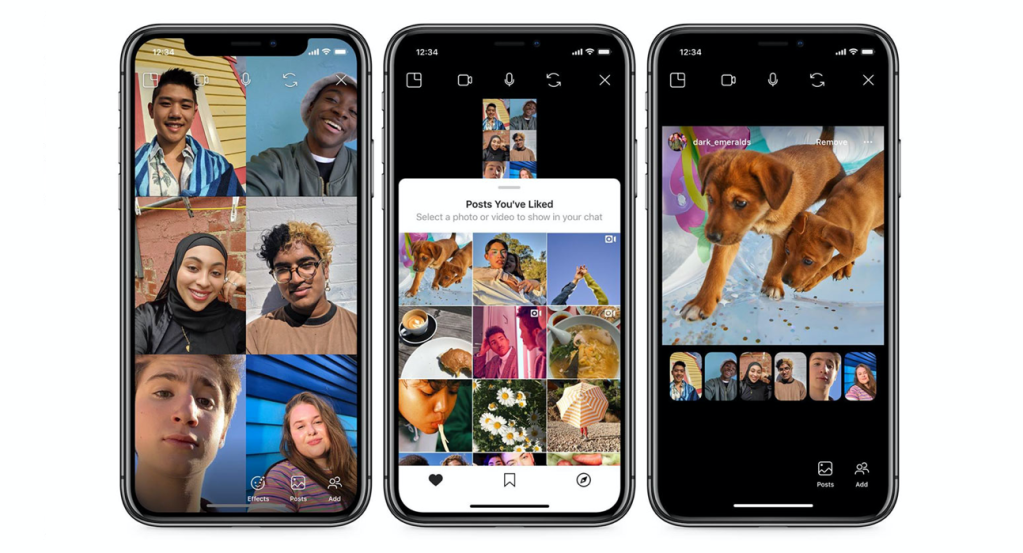Now you can scroll Instagram together with friends, turning a typically isolating, passive experience into something more social and active. Today Instagram launched Co-Watching, which lets friends on a video chat or group video chat browse through feed posts one user has Liked or Saved, or that Instagram recommends.
Co-Watching could let people ooh, ahh, joke and talk about Instagram’s content instead of just consuming it solo and maybe posting it to a chat thread so friends can do the same. That could lead to long usage sessions, incentivize users to collect a great depository of Saved posts to share and spur more video calls that drag people into the app. TechCrunch first reported Instagram was testing Co-Watching a year ago, so we’ll see if it managed to work out the technical and privacy questions of operating the feature.
 The launch comes alongside other COVID-19 responses from Instagram that include:
The launch comes alongside other COVID-19 responses from Instagram that include:
- Showing a shared Instagram Story featuring all the posts from you network that include the “Stay Home” sticker
- Adding Story stickers that remind people to wash their hands or keep their distance from others
- Adding coronavirus educational info to the top of results for related searches
- Removing unofficial COVID-19 accounts from recommendations, as well as virus-related content from Explore if it doesn’t come from a credible health organization
- Expanding the donation sticker to more countries so people can search for and ask friends for contributions to relevant nonprofits
These updates build on Instagram’s efforts from two weeks ago, which included putting COVID-19 prevention tips atop the feed, listing official health organizations atop search results and demoting the reach of coronavirus-related content rated false by fact checkers.
But Co-Watching will remain a powerful feature long after the quarantines and social distancing end. The ability to co-view content while browsing social networks has already made screensharing app Squad popular. When Squad launched in January 2019, I suggested that, “With Facebook and Snap already sniffing around Squad, it’s quite possible they’ll try to copy it.” Facebook tested a Watch Together feature for viewing Facebook Watch videos inside Messenger back in April. And now here we are with Instagram.
The question is whether Squad’s first-mover advantage and option to screenshare from any app will let it hold its own, or if Instagram Co-Watching will just popularize the concept and send users searching for more flexible options like Squad. “Everyone knows that the content flooding our feeds is a filtered version of reality,” Squad CEO Esther Crawford told me. “The real and interesting stuff goes down in DMs because people are more authentic when they’re 1:1 or in small group conversations.”
Squad, which lets you screenshare anything, including websites and your camera roll, won’t be fully steamrolled. When asked if Instagram would build a full-fledged screensharing feature, Instagram CEO Adam Mosseri said they’re “Not currently working on it . . . screensharing is not at the top of the list for us at Instagram.”
 With Co-Watching, Instagram users can spill the tea and gossip about posts live and unfiltered over video chat. When people launch a video chat from the Direct inbox or a chat thread, they’ll see a “Posts” button that launches Co-Watching. They’ll be able to pick from their Liked, Saved or Explore feeds and then reveal it to the video chat, with everyone’s windows lined up beneath the post.
With Co-Watching, Instagram users can spill the tea and gossip about posts live and unfiltered over video chat. When people launch a video chat from the Direct inbox or a chat thread, they’ll see a “Posts” button that launches Co-Watching. They’ll be able to pick from their Liked, Saved or Explore feeds and then reveal it to the video chat, with everyone’s windows lined up beneath the post.
Up to six people can Co-Watch at once on Instagram, consuming feed photos and videos but not IGTV posts. You can share public posts, or private ones that everyone in the chat are allowed to see. If one participant is blocked from viewing a post, it’s ineligible for Co-Watching.
Co-Watching could finally provide an answer to Instagram’s Time Well Spent problem. Research shows how the real danger in social network overuse is passive content consumption, like endless solo feed scrolling. It can inspire envy, poor self-esteem and leave users deflated, especially if the highlights of everyone else’s lives look more interesting than their own day-to-day reality. But active sharing, commenting and messaging can have a positive effect on well-being, making people feel like they have a stronger support network.
With Co-Watching, Instagram has found a way to turn the one-player experience into a multi-player game. Especially now with everyone stuck at home and unable to crowd around one person’s phone to gab about what they see, there’s a great need for this new feature. One concern is that it could be used for bullying, with people all making fun of someone’s posts.
But in general, the idea of sifting through cute animal photos, dance tutorials or epic art could take the focus off the individuals in a video chat. Not having one’s face as the center of attention could make video chat less performative and exhausting. Instead, Co-Watching could let us do apart what we love to do together: just hang out.
































Comment